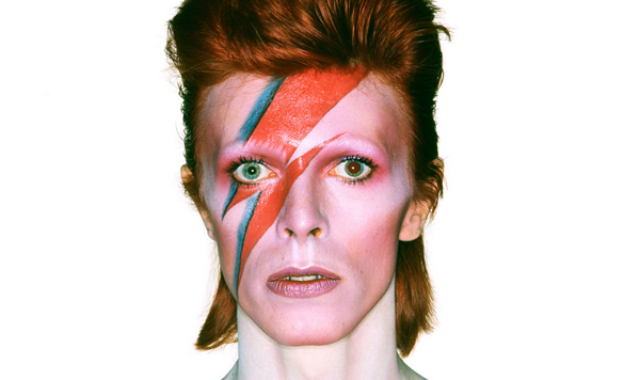Is: the third person, singular, present indicative conjugation of the verb to be. As I traveled through the exhibit David Bowie Is, which on display at Chicago’s Museum of Contemporary Art until January 4th – notably, the only US stop on the exhibit’s tour – I kept trying to figure out what it was about the title that felt unfinished to me. David Bowie Is.
Grammatically, it’s a complete sentence, but in everyday speech, there’s usually at least an adjective following the conjugated verb. True: it is a clever marketing strategy and the MCA has taken full advantage of it, both throughout the exhibit and on the promotional materials to market the show. But by the end of the exhibit, I arrived at a better understanding as to why the title felt unfinished, and the significance of this effect.
Verbs are actions, they move. And that’s exactly what David Bowie has always done, and what he continues to do. David Bowie is. The conjugation of the verb to be demonstrates that he is currently in a state of being: not stagnant, not finished. David Bowie constantly evolves, changes. Today this is a pretty common industry requisite: if artists want to stay relevant, they must continue to change in order to keep garnering an audience.
To me, the exhibition title also points towards another aspect of Bowie besides his successful ability to constantly remarket himself: he has never only explored a singular artistic discipline. Instead, his multiplicity as an artist is an essential aspect of his artistry. In essence, this multiplicity is what keeps him in the present tense, creating.
Though he’s best known as a musician, Bowie has also painted, drawn, written lyrics, stories, and plays, created rock operas, designed sets and lighting for shows, and even acted. This multiplicity is at the heart of the exhibit, which spans Bowie’s five-decade-long career (and counting), and presents over 400 artifacts from Bowie’s personal achieve. One of my personal favorite items was an oil painting of fellow musician Iggy Pop that Bowie painted when the two were living in Berlin because it proves that Bowie didn’t just dabble in other artistic disciplines, he actually excelled in them.
His versatility in the arts has been inspirational to many who see themselves as multidisciplinary artists, such as Kevin Barnes from Of Montreal and St. Vincent who will both perform and give talks later in November about Bowie’s influence over their artistic practices. To date the exhibit has incorporated events that have brought in dancers, musicians, art historians, and other performance artists that feel inspired by Bowie, proving that his influence is far reaching.
Instead of giving a run down of the contents of the entire exhibit – something that one can find countless articles about online and which may not propel one to visit the exhibit (which is my aim) – I’d rather focus on the importance of being inside the exhibit because this was clearly an exhibit that was hyper-aware of experience, which I believe, mirrors Bowie’s awareness of audience.
Every visitor is given a headset which plays a collage of audio – interviews, music, noise, etc – and is geo-sensitive, meaning the headset delivers audio according to where one is in the exhibit. This, coupled with the artifacts, costumes, video footage of interviews, performances, and other ephemera creates an environment that does not allow for stasis. The interior of the exhibit promotes movement because of its maze-like layout that is riddled with twists, turns, and alcoves.
There was one site-specific installation within the exhibit that I had trouble walking away from, which was was located close to the beginning. The installation consisted of a series of screens situated between large mirrors that showcased Bowie’s 1972 performance of “Starman” on the BBC’s Top of the Pops in 1972. A mannequin was placed to the right of the screens, dressed in Bowie’s iconic Ziggy Stardust costume – a jumpsuit designed by Freddi Burretti. Because of where the mirrors were placed, the costume and video performance refracted and replicated, causing you to feel as if you were encountering a 3-D kaleidoscope.
It’s no surprise that in Bowie’s multiplicity, I see a sort of refuge, an inspiration, an example of how I’d like to be and really, how I’d like to remain. As an artist who considers herself multidisciplinary, it’s difficult for people to understand that one can practice, and practice successfully, more than one art form. In an interview I conducted in October with Celia Rowlson-Hall, she echoed this sentiment by stating, “People have some weird notion that someone should only be good at ONE thing … or MAYBE two … but that’s pushing it. And if you do more than one thing, you must not be very good at it and that’s why you have to do a few things. I call BULLSHIT on that one.”
This exhibit is proof that artists shouldn’t restrict themselves to only one discipline. Instead, engaging in many artistic practices is what makes David Bowie David Bowie, and his ability to continually reimagine and try new things is what keeps his state of being in the present tense, which is something I think we can all agree, as artists and humans, is our preferred state of being.
*Photo taken by Brian Duffey for Bowie’s Aladdin Sane album

